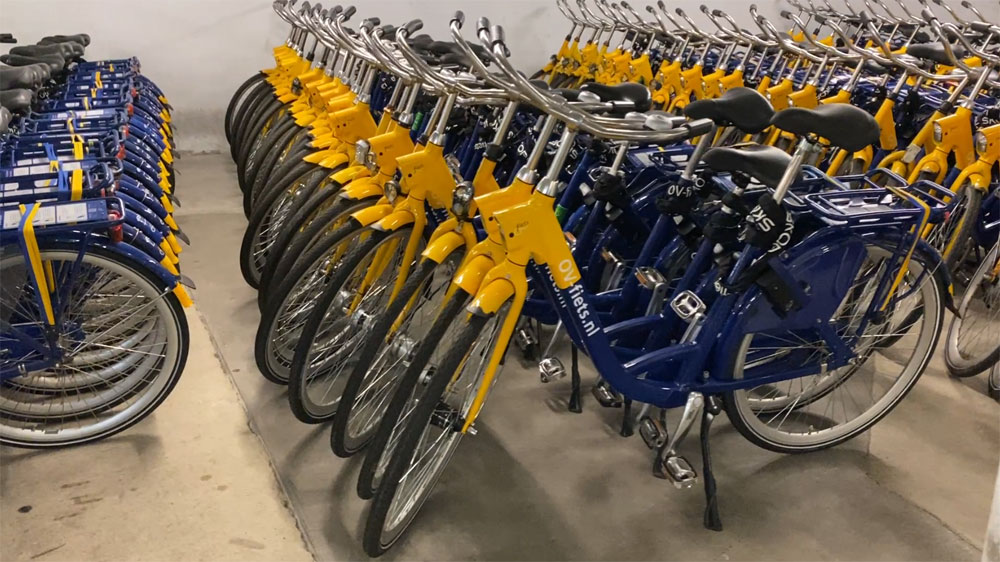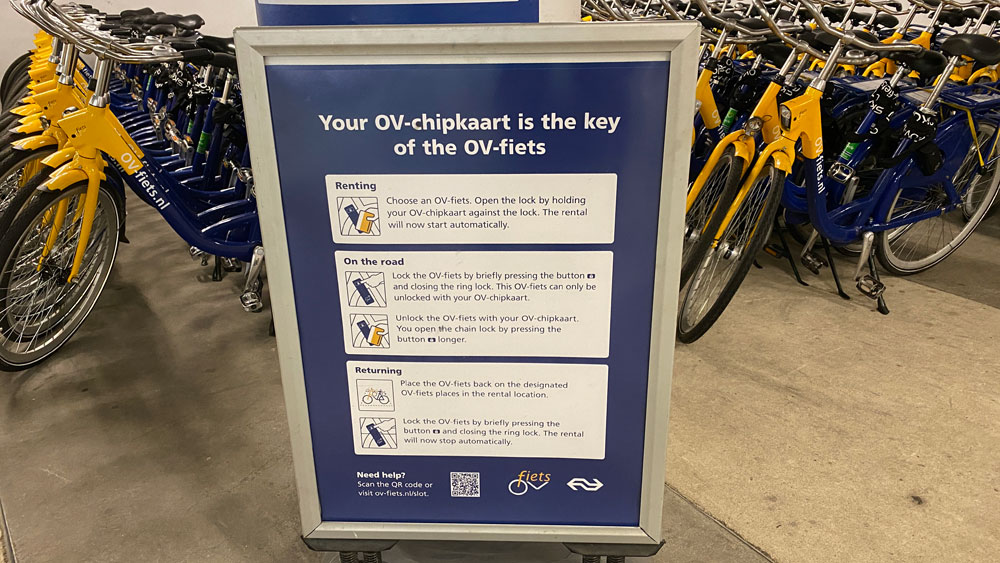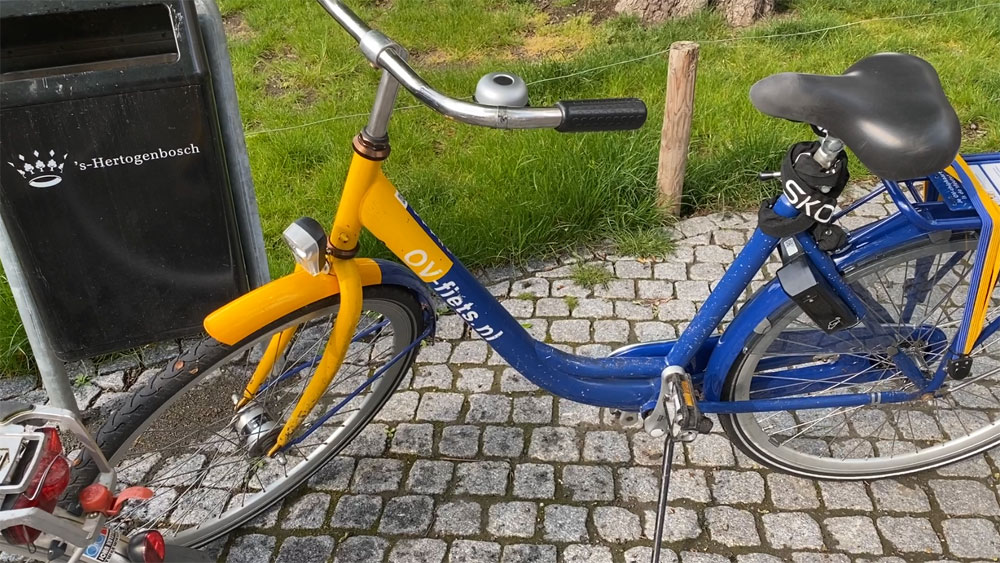The OV-fiets system is a very popular shared bicycle scheme in the Netherlands. This last mile solution for train travellers is constantly evolving. The latest development is that the bicycles now come with an electronic lock without the need for a key. The railway station of ʼs-Hertogenbosch was the second station to get these bicycles. In this blog post I test the new key-less rental system.

I use the bicycles of the OV-fiets system very often. OV stands for “Openbaar Vervoer” which means Public Transport. This blog could not have existed without the OV-fiets. With one of the bicycles from this system I can cycle to even the most remote locations, because I can get them at almost every railway station, even the smallest. The bicycles were upgraded in 2015, for which the public was asked to test 5 types on a test location in Utrecht. But they are upgraded again: most of the bicycles will get an electronic lock.
There are currently three ways to rent a bicycle. At the smallest stations there are some bicycles available from a locker. I showed how that system works at the station of Vierlingsbeek in 2020. The second way is with an automatic key disposal system which is used at bigger (unmanned) stations. That system changed considerably over the years. I showed you how it worked in Heerlen in 2011. At the time you had a separate subscription card and you needed to type in your full subscription number and a pin code on a key-pad. That is no longer needed. The subscription is now integrated with your electronic public transport card (OV-chip card) and in Bussum and Culemborg I showed you how easy it works now. You just have to tap your OV-chip card and answer a few questions to get the key for your bicycle from a locker. The third type of rental is used at the larger stations. There you have to let someone check the bicycle you want to rent and your OV-chip card to start the rental period and again to finish it.

One thing all three systems have in common: the bikes have a ring-lock with a key. This lock is a for the Netherlands typical and standard type of bicycle lock. It comes with a metal ring to prevent the back wheel from turning and an extension chain to lock the bicycle to a solid object. Apparently many people lose the keys; about 2,000 every year, which renders the bicycles useless until the lock is replaced. No wonder there is even a fixed penalty for when that happens; €20,=.
The keys will now be replaced by electronics, to simplify the system. From late 2019, there was a trial in Apeldoorn. Early 2021, my hometown of ʼs-Hertogenbosch was only the second location to get the new bikes. The Railways want to roll out the system quickly. In 2021, there will already be 45 locations with such new locks. It is expected that 70% of all rental bicycles will have these electronic locks by the end of this year.

I don’t usually rent a bike in my home town but this time I did to test it out. It is very easy indeed. Like in any major rental location the bikes are lined up, ready to be rented out. Earlier, they were all unlocked with the key in the lock and you went with a bicycle to someone to have it scanned. That person would also scan your OV-chip card and together that would start the rental period. You could lock the bike up at your destination and open it again with the key. When you came back to the rental location to return the bicycle, it would be scanned again, the rental period would end and you would leave the bicycle there, unlocked, ready for the next customer.
In the new situation all the bikes are lined up like before, but they are all locked now. You hold your OV-chip card next to the lock and that lock scans it. The system then starts the rental period at your name and opens the lock automatically. You simply take the bike and cycle away with it. There is no longer anybody involved to help you. Now that you do not have a key locking the bike up at your destination goes a little bit different. The lock has a small button. When you press it one second the lock is released and you can close the ring by pushing the lever down. If you also want to use the chain to lock the bike to a pole you would pull the end of the chain out of the lock before you close the ring. You loop the chain around a pole or fence and click the end back in its hole of the lock and only then you close the ring. After that your bicycle is locked up. Locking the rental bicycle up like this at any location does not end your rental period. The standard rental period of an OV-fiets is 24 hours for €3.95 and you can use it and lock it as much as you want in that time. (If you don’t return it there is an extra fee of €3.95 for the next 24 hours, and so on.) When you return to your locked-up bicycle all you have to do is hold your OV-chip card against the lock. The ring lock then pops open. If you used the chain you need to press the button for three seconds. It is then released from the lock. You can detach it from whatever you looped it around and put it back in its holding location of the lock.

When you want to end the rental period you need to return the bicycle to its home location. Since this system is an extension of the railway you will most likely return with the train from the station where you rented the bicycle, so that is then not a problem. You are allowed to return it at a different station, but that costs €10 extra. I have never had to do that.
When you get back to the station you park the bicycle with all the other bicycles. The lock is connected to some system and therefore it “knows” it is back where it belongs. If you now press the button and lock up the bicycle it does end the rental period. The bicycle is again lined up and locked up, ready for the next customer.

I found the new system very intuitive and easy to use. I do see some downsides. You have no proof that the rental period ended correctly. Many people said this after the trial in Apeldoorn and the railways quickly developed an app that you could download to check that. Another downside is more practical. All the bicycles are numbered and the keys have that same number. I do often get to places where many people arrived by OV-Fiets and they obviously all look alike. I used to identify which one was ‘mine’ by checking the number on the key and then finding the corresponding bicycle. Without the key you cannot do that. So I will have to better remember where exactly I parked ‘my’ bicycle. Other than that I can see that this is a much simpler system.
The OV fiets system is a very popular last mile solution that the Railways offer to their customers. In 2021, there are 21,700 bicycles available from almost 300 locations. In 2014, the bicycles were rented out for 1.5 million rides. By 2019, that figure had increased to 5.2 million. Due to Corona the number of rides decreased to about 3 million in 2020. The number of train journeys decreased to about 30% of the level of 2019. The number of OV-bike journeys is still at 60% of its pre-Corona average.

The OV-fiets system is still not available to tourists in an easy way, because it has to be connected to a Dutch bank account for the payment system to work. THE UTRECHT REGION PASS NO LONGER EXISTS. There is a loophole by getting a so-called Utrecht Region Pass. This is an electronic Tourist Card that works like an OV-chip card but now with a connection to a credit card. With this card you have access to museums and other tourist destinations in the wider Utrecht region, but also to all public transport and to the OV-fiets system in the entire country. The Utrecht Region Pass system involves picking up and returning a chip card from a location in the Utrecht region. You rent that card and you would have to order it in advance. So if you – as a tourist – would like to use public transport and rent OV-bikes like any Dutch person, it can be done, but it’s not the easiest thing to organise. That could definitely be a future improvement!
A major change to the OV-chip card system will be when the cards will be replaced by people’s bank card or smart phone. First that was believed to happen by the end of 2022. But Translink, the organisation which issues the cards, now said that it will take until at least the end of 2023. There may even be a new type of OV-chip card before people can use their smartphone in the future.


You actually don’t need a Dutch bank account anymore. The global fintech app Revolut is now a member of iDEAL so it can be used as well to pay for NS Flex. The bigger problem is that you have to have your personal OV-chipkaart delivered to a Dutch address and you have to provide a Dutch phone number. But you can probably use the address of your accommodation and a random phone number (as far as I remember it is not checked).
I would recommend ordering a NS Flex Dal Vordeel, which costs 5 € monthly (you can cancel it after one month and you will get refunded the unused payment to the last cent). If you order cheaper NS Flex tariffs, you will pay one-time setup fee of 10 € so it’s not worth it. If you use train off-peak the 5 € will pay back by 40% discount on each journey very soon, so it’s definitely worth it.
After one month, you can switch you NS Flex tariff to Zonder Abonnement which costs nothing. This way, you can have your OV-chipkaart ready for the next visit of The Netherlands.
Beware that you need to be in the Netherlands to be able to change your subscription as you need to activate any changes afterwards by holding your card next to a check-in pole within two weeks of the change. I’ve had so have a card sent to me from the US to do that for a friend. So not that easy either.
No, with NS Flex, you can change you subscription completely online, there’s no need to activate the changes on the card*. The difference between Flex and previous subscription is basically this: in the previous system, the subscriptions were actually written to the card memory (therefore you need to physically present the card at some machine), whereas with Flex, the card serves only as an identifier for a central database.
*) Source: https://www.ns.nl/en/customer-service/flex/changing-ns-flex.html
I did need to present my fiends card but that was indeed going to flex. Not changing from one type of flex to the other. It does show that the rules change constantly and you do need someone to help you in NL.
Thank you for this. I have been scratching my head for years about how to do this. Still not exactly straightforward, but I’ll look in to it.
While Corona has kept me away, it seems the NS app now takes Visa or Mastercard, which is a big step up. I tried to take a train at a local station in 2019, and there was no way to pay unless you had a IDeal linked card. The revenue protection staff on the train gave me a 30cm long penalty fare ticket, thankfully just for the fare, and I had to pay it by international bank transfer.
For such an outward looking nation the Netherlands has a surprisingly insular banking system. Can’t even use a Visa or Mastercard in the local supermarket. Cash is still king for the visitor.
Do the Dutch have problems with making card payments overseas?
Maestro is widely accepted in most of Europe even in countries where banks issue Visa and MasterCard. So the Dutch should have little problem when travelling.
I would argue that other countries have the “problem” and should issue Maestro instead of Visa and MasterCard because the processing fees for Maestro are vastly lower. This means that small retailers in the Netherlands have long been prepared to accept card payments for low value transactions than in some other countries. The Dutch realise that increased acceptance of Visa and MasterCard means increased prices. The high transaction costs need to be paid somehow.
An anonymous card won’t work because it is not linked to a bank account, so if you don’t return or damage the bike they cannot charge you for it.
Other bike hire systems use credit cards as insurance so I can’t see why that wouldn’t work. The Utrecht loophole mentioned links an OV-Chipkaart to your credit card. I guess they haven’t bothered with this in the Netherlands because a lot of people don’t have credit cards and this system is primarily for domestic customers.
In 2018 I was able to get a personal OV chip card with the help of a NL friend. I’d hoped to use it for renting OV fiets on a 2019 visit with two other USA friends. But, I still couldn’t because I wasn’t able to link a bank account to deposit one penny or some such small amount to activate the bike rental on my card. It was so disappointing because the OV fietsen are so great – comfortable, simple, useful. We had to commercally rent bikes which cost waaaay more. It looks like they’re changing the system so visitors can rent now? I hope so.
Can you use an *anonymous* OV-chipkaart to rent an OV-fiets this way? Or indeed a contactless debit or credit card? Because if either of these are possible then this would be useful for tourists.